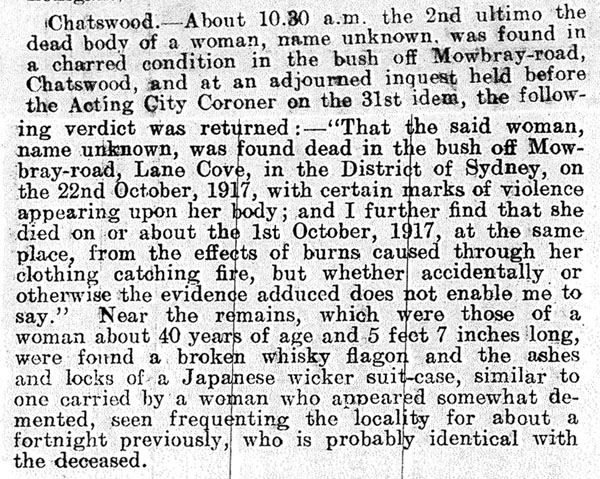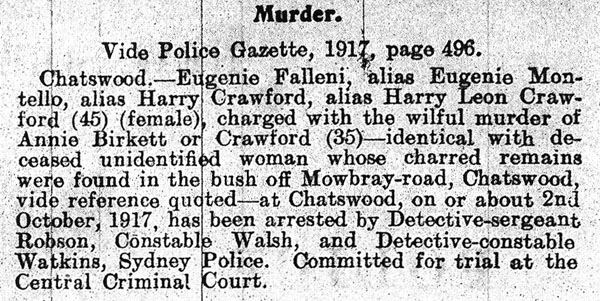Police Gazette, 1920.
After Annie's disappearance, Harry told friends and neighbours that
Annie had left him for another man. He
soon sold off the family
belongings and furniture from their home. Annie Birkett's son Harry
never believed
that his mother had absconded and not made contact
with him or his aunt in the subsequent years. He
placed this missing
notice in the Police Gazette three years after Annie's
disappearance.
When Annie's body was identified, suspicion fell on
her husband, Harry Crawford. He was arrested by the
Chatswood Police
on 22 July 1920 and taken to the Central Police Station for
questioning and to take part
in identification parades. Harry had
just married another woman and was still wearing men's clothes, had
short dark hair and looked very masculine. He only revealed his true
identity as a woman when he was
threatened with going to a mens'
gaol. From NRS 10958 Police Gazette NSW, 1920 [1/3252, p.474]
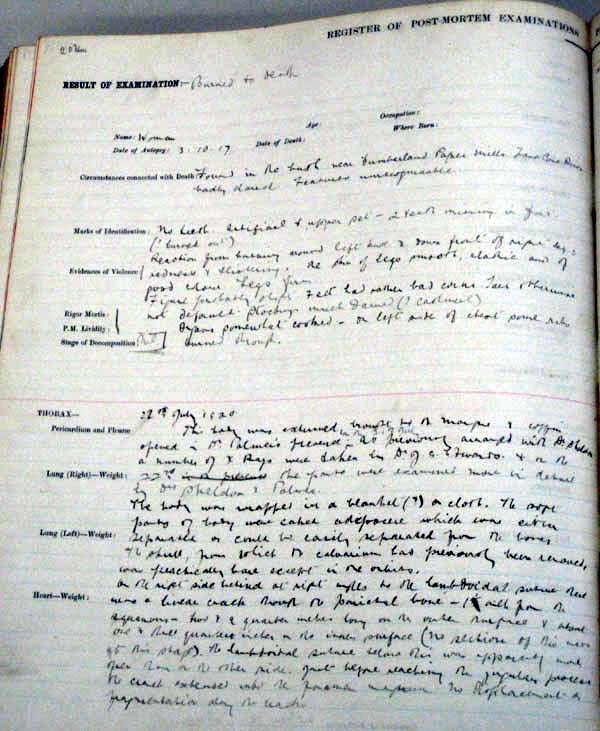
Post mortem register.
The first autopsy on the unknown woman was undertaken on 3 October
1917 (see top half of page). There were
many fissures or fractures
in the skull, mainly due to the heat of the fire, but the coroner
could not tell whether
she was dead before the fire started. The
initial inquest returned an open verdict on 31 October 1917.
Annie's
body was exhumed and re-examined on 22 July 1920, maybe in an
attempt to positively identify the
remains (see bottom half of
page). A large linear crack to the back of the skull was discovered
under xray.
From NRS 1789 [3/2209] Post Mortem registers, 1916-18.
Close up of left hand side of page in the post
mortem register.
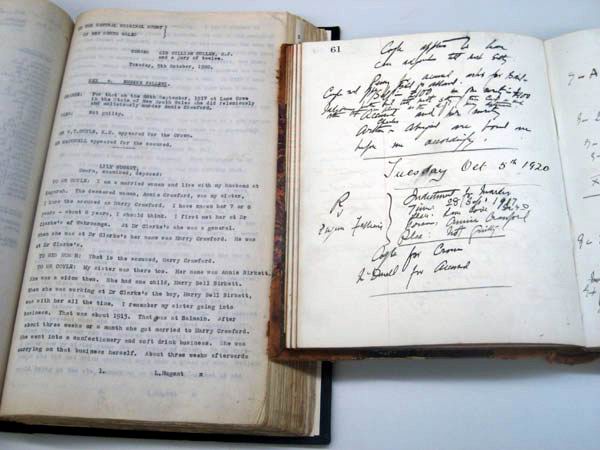
Two main records of the Falleni trial.
This photo displays the two main records of the Falleni trial held
in the State archives. On the left hand
side is the typed record
from the Court Reporting Office of the trial. The other volume is
the handwritten
notebook of Chief Justice Cullen, the trial judge.
Both volumes are open to the first day of the trial.
Falleni pleaded
Not Guilty to the charge of 'feloniously and maliciously' murdering
Annie Birkett. Eugenia
claimed to have been 'unnerved by three
months detention in Long Bay gaol and could not speak as she
wished
in declaring her innocence'. The 'Man-Woman' trial caused a media
sensation not just in Sydney
but Australia wide. No real explanation
was offered though, as to why Falleni acted as she did.
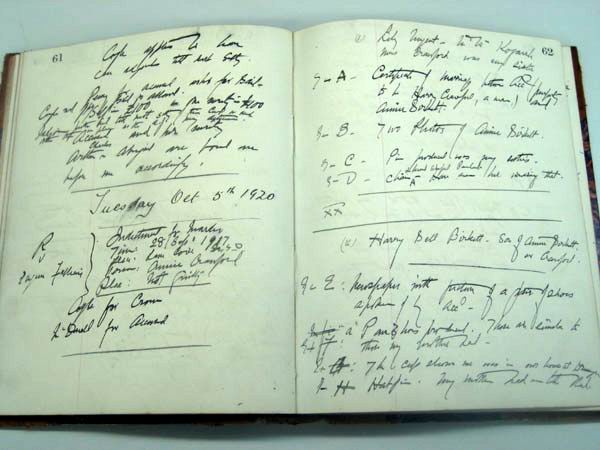
Chief Justice Cullen's notebook.
This handwritten record of Falleni's trial was kept by the presiding
judge, Chief Justice Cullen. The trial started
on 20 October 1920
and lasted for two days. Falleni's defence started after lunch on
the second day and was
concluded by 3.10pm. The prosecution case was centred on proving that the body was that of Annie Birkett
and that
Falleni was the last person to see her alive.
There were numerous
witnesses testifying to the rocky relationship and the distraught behaviour of Falleni in
the weeks after the murder. Much of the
evidence focused on the timeline in the week surrounding Annie's
disappearance when Falleni was distraught and frequently found
drinking alone.
The evidence of Annie Crawford's son, Harry Bell Birkett, starts on the right hand page. Eugenia's daughter
Josephine, hiding behind a black veil, also gave evidence at the
trial. NRS 5808 [7/9318], handwritten
notebook of the presiding
judge, Chief Justice Cullen, at the Falleni trial.
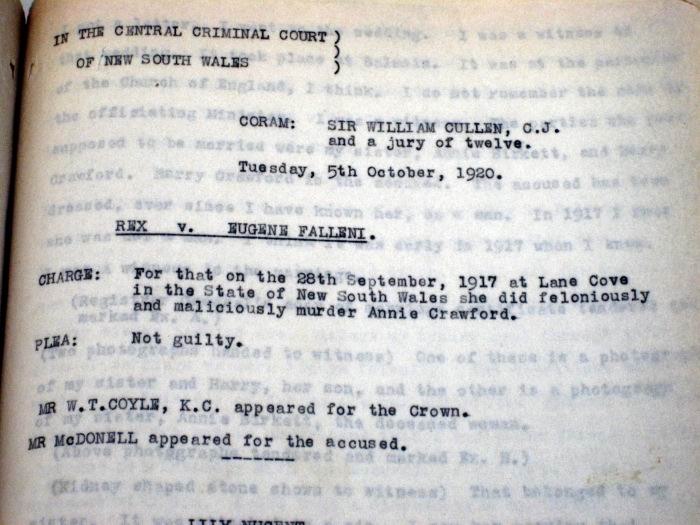
Court transcript - verdict.
The transcript is open to the first day of trial. Falleni continued
to deny the charges and made a statement in
her defence from the
dock: 'I do not know anything at all about this charge. I am
perfectly innocent. I do not
know what made the woman leave her
home'. Falleni continued with this line of defence even though the
body of Annie Birkett was identified by dental records, clothing and
jewellery.
The evidence of Henrietta Schielblich was perhaps the
most damning though. Henrietta spoke of a conversation
with Falleni
in the weeks following Annie's death when a distraught Falleni
claimed to have had an argument
with Annie: 'I had a jolly good row
with her and gave her a crack on the head and cleared [off]'. NRS
2713
[6/1077 p.68], Court Reporting Office.
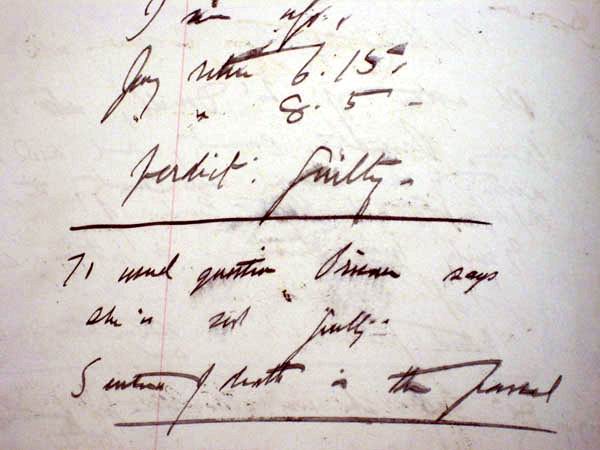
Justice Cullen's notebook - verdict.
This is the last entry in the Justice Cullen's notebook with the
guilty verdict and death sentence. The jury
deliberated for about
two hours before returning the guilty verdict. Falleni continued to
claim that she had
never been to the area in Lane Cove where the
body was found and said she was found guilty 'on false
evidence'. NRS 5808, [7/9318], p.99.
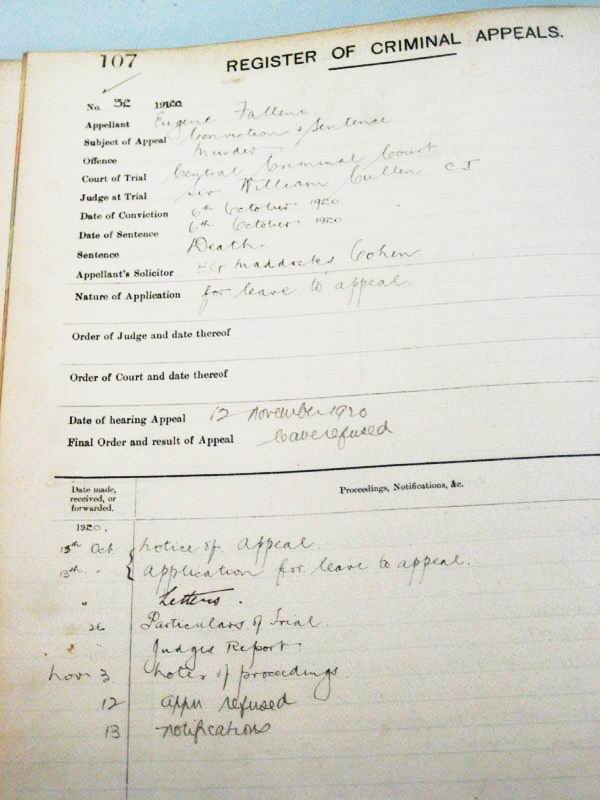
Criminal Appeal, 1920.
Falleni requested leave to appeal her conviction on 13 October 1920.
This request was refused on 13 November
1920 but a State Cabinet
meeting on 30 November 1920 agreed to commute her death sentence to
a life
sentence. She was eventually released from gaol early due to
continued ill health in 1931.
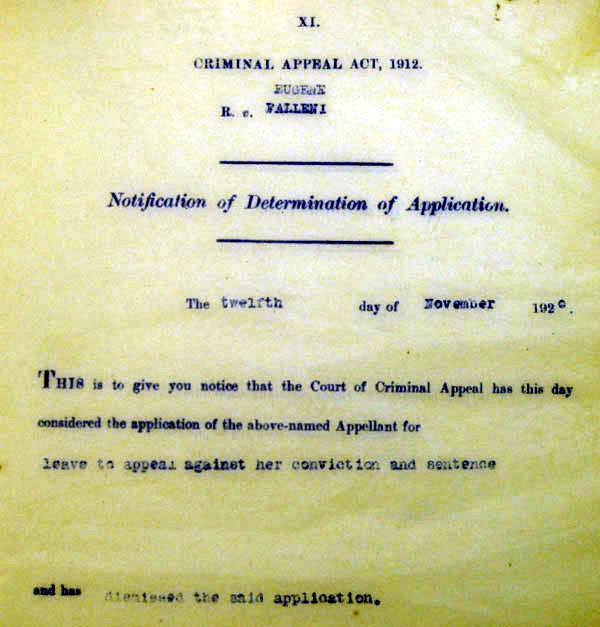
Criminal Appeal, 1920.
One of many letters that relate to Falleni's attempts at appeal.
This one notifies her of the dismissal of
her application to appeal
her sentence. There are a number of letters relating to Falleni in
this volume
but many are hard to read as the volume contains carbon
copies of letters only. NRS 2698 [3/4819],
Court of Criminal Appeal
letter book.
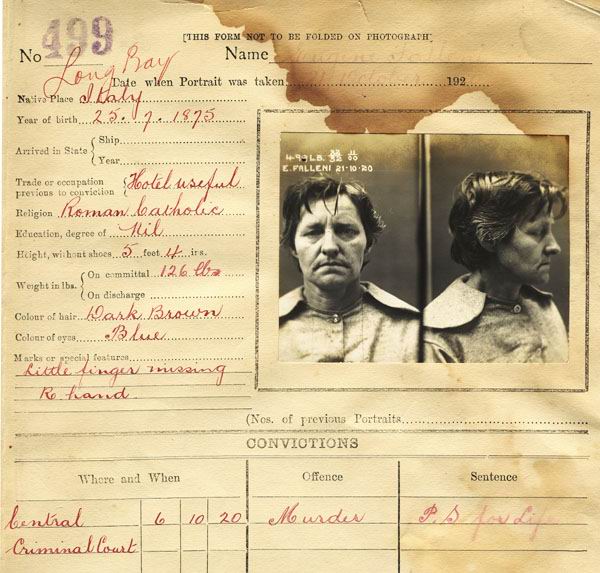
Gaol photograph, 1920.
This photo was taken in 1920 soon after the end of Falleni's trial.
She was 45 years old and at the begining
of her life sentence. A
short haired Falleni could easily pass for a man by the looks of
this image. There are
references in her trial to the accident that
lead to Falleni losing her little finger (the accident occured
between 1917 and 1920). Another gaol photo was taken eight years
later. From NRS 2496 [3/6006
p.499, 1920], State Reformatory for
Women, Photo description books.
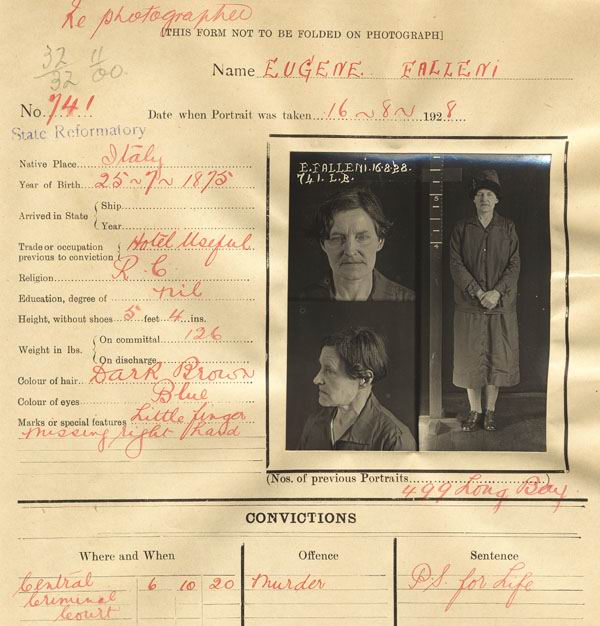
Gaol photograph, 1928.
This is a later gaol photo of Falleni, taken in 1928. This image
shows an older Falleni in three different poses.
The clothes Falleni
is wearing in the photo were often provided by the gaol or the
photographer and were not
necessarily her own. In comparison to the
previous goal photo taken in 1920, this photo shows a softened
and
more feminine Falleni. She is about 53 years old in this photo and
she was released from gaol in 1931,
three years after this photo was
taken. Her early release was on compassionate grounds due to
continued
ill health. From NRS 2496 [3/6007 photo 741, 1928], State
Reformatory for Women, Long Bay,
Photo description book.

Long Bay Description Card.
The reverse side of the description card contains the gaol history
of Falleni, including time spent in the Coast
Hospital. There are
several references to Falleni in NRS 2502, Record of cases treated
in Gaol hospital.
Falleni was released in 1931 under the assumed
name of Jean Ford. The other side of the description
card contains similiar details as to what is on the photo description records. NRS
2493 [11/3128],
State Reformatory for Women, Long Bay, description
card, Side B.
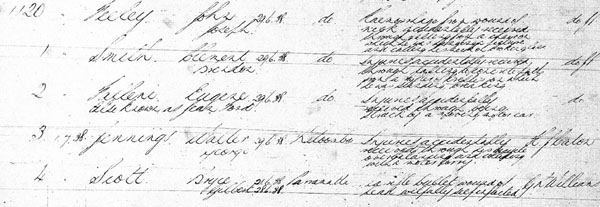
Falleni's death, 1938.
Falleni died in Sydney Hospital on 9 June 1938 after being struck by
a motorcar on Oxford Street, Sydney.
This entry from the Coroner's
inquests register shows: inquest number (1122); date proceedings
received
at Dept (30 June 1938); name of deceased (Eugene Falleni
also known as Jean Ford); date inquest held
(29 June 1938); where
held (Sydney); Verdict (accident); Coroner (illegible). No other
inquest papers
have survived. Falleni was buried in Rookwood
Cemetery. NRS 343 [3/960, #1122 in 1938], Registers
of Coroners'
inquests.
Eugenia Falleni biography

